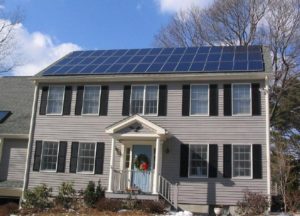
Using drones for residential solar: DroneDeploy software allows Sunrun to conduct roof inspection without risk to workers
By Jim Magill
Drone technology is spurring the growth of another innovative industry, the residential solar power industry.
Beginning in 2019, Sunrun, the leading home solar system installer in the U.S., began working with DroneDeploy to develop a drone-based solution to the challenges posed by having to send its technicians onto homeowners’ rooftops to take measurements, a time-consuming and potentially dangerous job.
“We were still hand-measuring roofs using tape measures. There’s a lot of human error involved in that,” Paul Helm, Sunrun project manager, said. “Our technicians were spending upwards of three to four hour per site, which made it really difficult to hit the targets we were setting of multiple surveys per day.”
Sunrun teamed up with DroneDeploy to launch its drone program in the latter part of 2019, and started building its drone fleet with the purchase of 110 DJI Mavic 2 Pro drones in December of that year.
“It was guidance from DroneDeploy that landed us on that particular model because it integrated into their platform really well,” Helm said.
Using Drones for Residential Solar Surveys: From 2 Hours to 15 Minutes
The company now flies about 245 drones and employs the same number of site technicians who are certified as Part 107 drone pilots. In its peak month, Sunrun conducted 7,000 drone flights recording data on customer roofs from the ground using DroneDeploy’s mapping software. The drone program has reduced the time for site technicians to complete a survey to an average of 15 minutes versus two hours for manually conducted surveys. It has also reduced the number off issues involving the fitting of solar installations by 35%, Sunrun said.
Helm said that before the company began employing drones there was a great variation in the amount of time site technicians spent measuring a roof. “It could take anywhere from 15 minutes on a simple rectangular roof to three and a half hours on these larger mansions in our Texas market,” he said.
DroneDeploy’s software allows Sunrun to create an interactive site view of the roof, creating maps, photos, panoramas and videos.
The software package automatically takes the mapping data and converts it to a digital file, pulling out the measurements needed to design a rooftop solar array, Katie O’Leary, DroneDeploy’s director of product marketing, said in an interview. A digital file of the measurements is then sent to the designer who can plug the data into a computer-aided design (CAD) program to create the layout of the planned solar array.
“By not putting someone on the roof, you’re removing that hazardous element out of the equation. You’re now allowing them to stay on the ground and you’re getting more accurate and timely information,” O’Leary said.
The map and model captured by using drones for residential solar also gives Sunrun a 3D view of the entire house that would be next to impossible to capture for a site technician standing atop a roof. This becomes important in cases where the designer needs to see a specific portion of the roof to ensure that the proposed solar array could be installed in that area correctly, Helm said.
“When DroneDeploy exports their map and model, we now can zoom in on any portion of the roof and see any part of it because the drone has a 4K camera, which allows us to get great detail,” he said.
Aside from increasing the efficiency of its operation, for Sunrun the most important benefit of its drone roof-inspection program has been the effect it has had on the safety and morale of its work force.
“It’s a giant win for us and our site technicians. Measuring a roof manually is very physically demanding. It’s mentally stressful, it’s taxing and it’s exhausting,” Helm said.
Before the company converted to drone-based roof inspections, its technicians would have to climb atop roofs in a variety of difficult conditions, such as 120-degree days in Las Vegas, when “the roof is radiating about 150 degrees back in your face,” he said. “The morale has gone up quite a bit because they’re not completely exhausted by the end of the day.”
Helm said Sunrun’s adoption of drone-related technology is only in the beginning stages. “We’re actually just scratching the surface,” he said. “We see the potential for drones and supporting equipment to really create an autonomous site survey.”
DroneDeploy has developed a software service that allows inspectors to do a 3D walk-through of a building. Just as the software company’s map and model system allows Sunrun technicians to conduct inspections of rooftops, DroneDeploy’s program can enable the solar technician to conduct pre-programmed drone inspections of attics and other difficult to access interior spaces.
“That’s absolutely life-changing for us. Now a site technician can just open doors for the drone and let it in and fly around,” he said.
“Over the last couple of years, we’ve added a lot of capabilities so now we’re really capturing entire perspectives of sites or facilities,” DroneDeploy’s O’Leary said. Using her company’s technology, customers such as Sunrun now have the ability to connect with a 360-degree camera to capture 3D images and to create digital twins of interior spaces, she said.
Read more about DroneDeploy: DroneDeploy’s newest release and products, funding and investment, disaster response efforts, and progress towards one-button processing.
Miriam McNabb is the Editor-in-Chief of DRONELIFE and CEO of JobForDrones, a professional drone services marketplace, and a fascinated observer of the emerging drone industry and the regulatory environment for drones. Miriam has penned over 3,000 articles focused on the commercial drone space and is an international speaker and recognized figure in the industry. Miriam has a degree from the University of Chicago and over 20 years of experience in high tech sales and marketing for new technologies.
For drone industry consulting or writing, Email Miriam.
TWITTER:@spaldingbarker
Subscribe to DroneLife here.